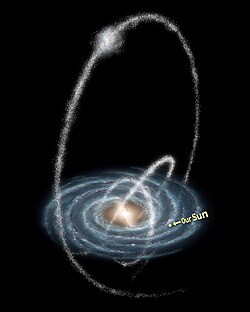| Name | Location | Origin | Mass
(solar masses) | Length
(light-years) | Composition | Characteristics | Discovery year |
|---|
| Young Blue Tidal Stream [27] | NGC 5128 | A gas fragment or
a dwarf galaxy | | | | | 2002 |
| stream 947-4966 | NGC 4013 [28] | former dwarf satellite
with low inclination orbit | | | | large looping structure | 2008 |
| 9477-J0949.4-STO 749988 (SMS J 4977449 tI947) | NGC 5907 [29] | low-mass satellite accretion | | | | multiple surrounding loops | 2009 |
| NGC 4651 [30] | satellite accretion | | | | narrow jet-like structure and surrounding debris shell | 2010 |
| NGC 3521 [30] | satellite accretion | | | | jet-like structure and surrounding debris shell | 2010 |
| NGC 7531 [30] | satellite accretion | | | | surrounding debris shell | 2010 |
| NGC 1084 [30] | satellite accretion | | | | three giant disconnected plumes of similar width | 2010 |
| NGC 4216 [30] | satellite accretion | | | | ongoing tidal disruption of satellite galaxies
seen as long tails extending from the progenitor satellite | 2010 |
| NGC 1055 [30] | satellite accretion | | | | clear box shaped inner halo sprinkled with a plethora of coherent spikes | 2010 |
| NGC 5291 [31] | galaxy interaction | | | | two separate tidal tails to the north and south | ? |
| petal of the sunflower | Messier 63 (NGC 5055) [32] | dwarf satellite accretion | 4x108 | | | | 1979/2011 |
| NGC 5387 [33] | satellite accretion | 6x108 | 11.7 kpc | young stars | enhanced star formation, metal-poor | 2014 |
| feather on the hat | Messier 104 (NGC 4594) [34] | major merger | | | | extremely metal rich | 2021 |
| NGC 4303 [35] | leftovers of a dwarf galaxy that was torn apart by M61's gravity | 2x108 | 50 kpc | | first stellar stream discovered with the Vera C. Rubin Observatory | 2025 |
|


